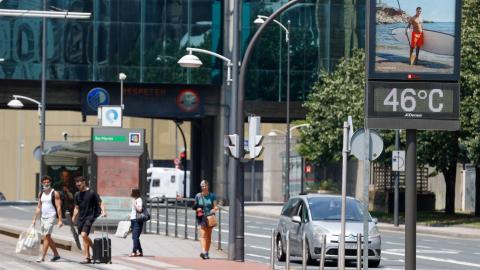Climate change affects both the frequency and magnitude of wildfires, and the increase in the number of days with Saharan dust intrusions, two issues that also impact people's health. Now, a study led by the Carlos III Health Institute (ISCIII) has analyzed how both phenomena influence hospital admissions for mental disorders.
"This is the first time something like this has been done," highlighted Julio Díaz, co-author of the study and co-director of the Climate Change, Health, and Urban Environment Unit at the Carlos III Health Institute (ISCIII), during a briefing organized by the Science Media Centre Spain.
The work analyzes the relationship between daily emergency hospital admissions for mental disorders in Spain, and the daily average concentrations of PM10, PM2.5, nitrogen dioxide (NO2), ozone (O3), and the daily maximum temperature during heatwaves. "We have taken into account all mental and behavioral disorders, and then specifically anxiety and depression," explained Díaz, who is also a research professor and principal scientist at the National School of Public Health of ISCIII.
The results, published in Science of The Total Environment, indicate that on days with biomass combustion (due to fires), PM concentrations have an effect on urgent admissions for mental disorders, especially depression, "which would be related to greater toxicity of PM," the scientist noted.
However, while there is an increase in PM concentrations on days with Saharan dust, these types of admissions are more related to other variables, such as the temperature during heatwaves, NO2, or O3, which also increase on these days. "Even with a higher PM concentration, it does not affect admissions for mental illnesses," Díaz noted during the session.
"When there is a heatwave, ozone and temperature spike, it is more likely that Saharan dust arrives, that there are wildfires, and foodborne illnesses..." He added, "It doesn't make sense to only look at the value of PM."
The study period covered from 2009-2018 and included data from a representative province in each of the nine regions in which Spain was divided to analyze natural particulate matter intrusions: A Coruña, Las Palmas, Madrid, Málaga, Balearic Islands, Seville, Valencia, Vizcaya, and Zamora.
A public health issue
Saharan dust intrusion is an increasingly common phenomenon in Spain. "In some places, it reaches 30% of days," noted Díaz, emphasizing that it is important "not to see it as a divine punishment."
In response to these episodes, the scientist insisted on the need to take measures, such as limiting the number of vehicles on the roads, to contain PM levels. "I can't eliminate those coming from Saharan dust, but I can lower the concentration or emissions of anthropogenic origin [...] that is, those emitted by cars," he clarified.
Díaz also referred to large-scale wildfires and warned that people who may be exposed to health damage do not have to be the closest ones.
As the researcher explained, designing this type of study is complex. "You have to choose populated areas, but that have Saharan dust intrusion or where there have been, for example, wildfires," clarified the author. This makes the scope of the results limited. "The numbers are very small," noted the author, "you can't infer causality."
Researchers from the University of Alcalá, the State Meteorological Agency (AEMET), and the Center for Energy, Environmental, and Technological Research (CIEMAT) also participated in the research.




